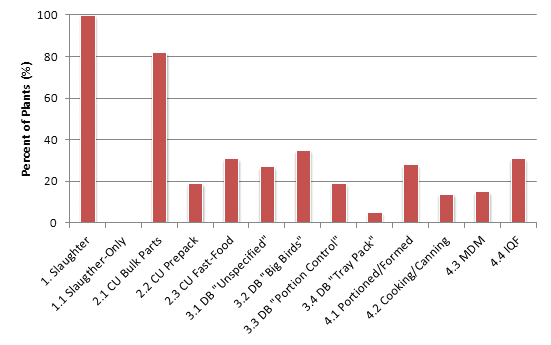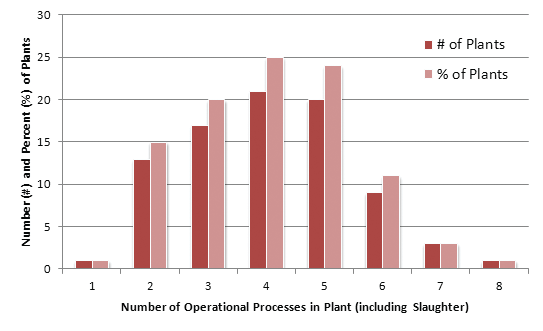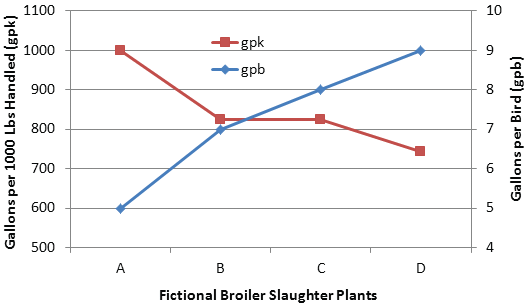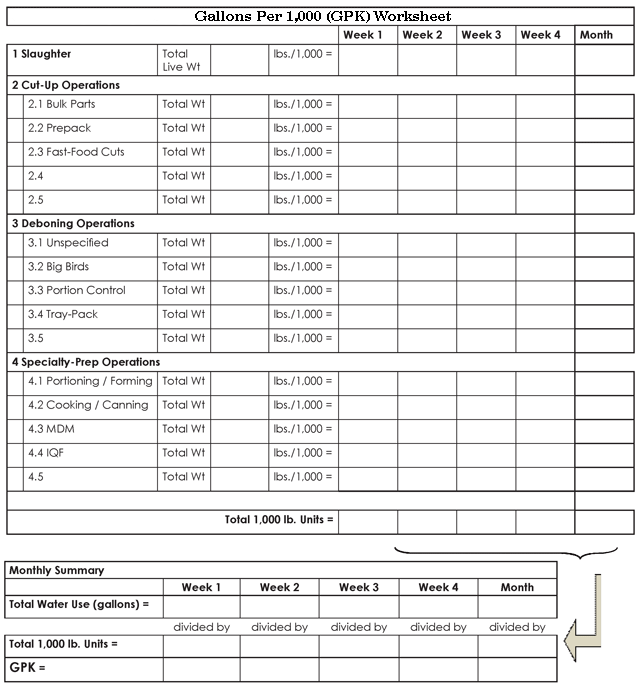- Importance of Accurate Water-Use Tracking
- The Modern Poultry Slaughter Plant
- Converting Your Plant to Gallons Per 1,000 (gpk)
- Advantages of gpk over gpb
- Comparison of gpk and gpb
- Converting to Gallons per 1,000 Pounds Handled (gpk)
- Gallons Per 1,000 (GPK) Worksheet
U.S. poultry processors slaughter approximately 9 billion broilers annually. The state of Georgia accounts for 1.4 billion (15%) of the national total, making it the country's top poultry producer. Poultry slaughter involves processing a live bird and converting it into wholesome, edible meat suitable for human consumption.
For decades, U.S. poultry slaughter plants solely produced intact whole (primary-processed) carcasses that were then sold to retailers and restaurants for further processing and sale. However, as society's demand for convenience-based food products has continued to grow, the modern poultry slaughter plant has shifted from the traditional primaryonly processing model to a more complex operation that encompasses multiple further processing steps. Only a few primary-only processing plants remain in operation in the U.S. Today's modern poultry processing plant slaughters more than 200,000 birds per day and includes, on average, three additional processing operations within the broad categories of cut-up, deboning and specialtypreparation. Despite this shift towards more complexity in poultry slaughter plant operations, many aspects of facility operations still rely on the dated primary-only processing model to monitor plant efficiency. This is the case with the monitoring and tracking of water use.
The industry standard established decades ago for tracking water-use efficiency within poultry slaughter plants (and as a means of comparing water use between facilities) is gallons of water used per bird slaughtered, or more simply Gallons Per Bird (gpb). The gpb calculation is simple:
This traditional calculation was effective at monitoring a plant's water use over time and comparing water use among plants when the traditional primary-only processing plant model was true. However, the simplistic gpb calculation does not provide a true indication of today's plant water-use efficiency.
It is the goal of this publication to introduce the development of a more accurate measurement of water-use efficiency based on the bulk quantities of materials handled at each processing step at a poultry slaughter plant. This new unit of measurement is the gallons of water use per 1,000 pounds of material handled, or Gallons Per 1,000 (gpk). The gpk calculation is also simple:
Gallons Per 1,000 (gpk) has a logical advantage over gpb in that it takes into account the additional processing steps that U.S. poultry slaughter plants encompass today. This advantage also holds true over the alternative water-use efficiency unit of Gallons Per Pound of Finished Product that some plants use.
Importance of Accurate Water-Use Tracking
Georgia, like most states in the Southeast, has been subject to extended periods of drought that have resulted in a heightened awareness of water as a precious and often limited natural resource. Recognizing the importance of planning for the sustainable use of water resources, the state developed the Georgia Statewide Comprehensive Water Management Plan and the subsequent Water Conservation Implementation Plan in the mid-2000s. In 2009 Dr. Carol Couch, director of Georgia's Environmental Protection Division, was asked what the state's most challenging environmental issues in the coming decades would be. Her answer was, "WATER, WATER and WATER."
Georgia's poultry industry must be ready to make environmental regulators, elected officials and the general public aware of the efficient ways that poultry processors use water in the preparation of wholesome and safe poultry products. The Gallons Per 1,000 (gpk) unit of water-use measurement can be utilized to show industry efficiency today, in the future and even in the past (see Advantages of gpk over gpb).
The Modern Poultry Slaughter Plant
In 2009, U.S. broiler processing plants slaughtered more than 8.5 billion birds totaling a live weight of more than 47.6 billion pounds (an average live weight of 5.6 pounds per bird). These broilers were processed in more than 160 facilities located in 30 states. Each broiler slaughter plant was thus responsible for processing, on average, 52.5 million birds during the year ? that?s just over 1 million birds per week, or approximately 200,000 birds per day.
Each year WATT PoultryUSA (www.wattpoultryusa-digital.com) conducts an extensive survey of the U.S. poultry processing industry. This survey tracks the type of poultry processed (i.e., broiler, turkey), plant location (i.e., city, state) and processing operations taking place in each facility. In the survey, poultry processing is divided into four basic categories, with three of those categories being further subdivided:
- Slaughter (i.e., live poultry processing to whole carcasses)
- Cut-up
- Bulk Parts (cut-up parts packed in bulk bags, boxes, bins)
- Prepack (cut-up parts prepacked in wrapped trays)
- Fast-Food Cuts (cut-up parts produced under customer specifications)
- Debone
- Deboning of carcass: Unspecified
- Deboning of "Big Birds"
- Deboning of "Portioned Control Birds"
- Deboning of "Tray-Pack Birds
- Specialty Preparations
- Detailed Portioning or Forming of Deboned Meat
- Cooking or Canning of Deboned Meat
- Mechanically Deboned Meat (MDM)
- Individually Quick Frozen (IQF) Product
Survey respondents may identify up to 12 separate operational processes for poultry entering their plant to produce that facility?s specific product mix. To understand the diversity of today?s U.S. poultry slaughter plants, and highlight the need to evaluate water use beyond the traditional gpb unit of measure, the 2010 WATT PoultryUSA survey results (www.wattagnet.com/uploadedFiles/1002USplants.pdf) for the nation?s top five broiler-producing states (i.e., Georgia, Arkansas, Alabama, Mississippi and North Carolina, representing 55% of U.S. production) were analyzed.
The WATT PoultryUSA survey shows the top five poultry-producing states contain 85 broiler slaughter plants: Ga.-19, Ark.-19, Ala.-19, Miss.-15, and N.C.-13. Only one of the 85 total broiler plants was identified as a primary-only processor. The remaining 84 facilities listed at least one additional further processing operation. Table 1 shows the portion of these 85 total slaughter plants conducting each further processing operation. Figure 1 shows the same data as a percentage of the total number of plants. The cut-up of carcasses into parts destined for bulk packing is by far the most prevalent further processing step undertaken in broiler slaughter plants, with 70 (82%) of the 85 plants producing bulk parts. The remaining 10 further processing operations are used by 30 (35%) or fewer of the 85 total plants.
The survey also shows that broiler processing plants range from one primary-only processing facility to a slaughter plant that lists seven further processing steps. Figure 2 shows the number and percentage of the operational processes conducted at the 85 plants. The survey results show that the average broiler slaughter plant in the top five producing states conducts four operational processes (primary plus three additional further processing steps). Georgia alone highlights the diversity of modern broiler slaughter plants. The 19 Georgia broiler slaughter plants in the survey list 15 different combinations of primary and further operational processes.
| Table 1. Number of broiler slaughter plants conducting various operational processes for facilities in Ga., Ark., Ala., Miss. and N.C. (85 total plants) | ||
| Operational Category | Operational Processes | Number of Plants |
| 1. Slaughter | 85 | |
| 1.1. Slaughter Only | 1 | |
| 2. Cut-up | ||
| 2.1. Bulk Parts 2.2. Prepack 2.3. Fast-Food Cuts |
70 16 26 |
|
| 3. Debone | ||
| 3.1. DB Unspecified 3.2. DB "Big Birds" 3.3. DB "Portion Control Birds" 3.4. DB "Tray-Pack” Bird" |
23 30 16 4 |
|
| 4. Specialty-Prep | ||
| 4.1. Portioned/Formed 4.2. Cooking/Canning 4.3. Mechanically Deboned Meat (MDM) 4.4. Individually Quick Frozen (IQF) |
24 12 13 26 |
|
 Figure 1. Percentage of broiler slaughter plants conducting various operational processes for facilities in Ga., Ark., Ala., Miss. and N.C. (85 total plants)
Figure 1. Percentage of broiler slaughter plants conducting various operational processes for facilities in Ga., Ark., Ala., Miss. and N.C. (85 total plants)
 Figure 2. Number (#) and percentage (%) of operational processes taking place in broiler slaughter plants in Ga., Ark., Ala., Miss. and N.C. (85 total plants)
Figure 2. Number (#) and percentage (%) of operational processes taking place in broiler slaughter plants in Ga., Ark., Ala., Miss. and N.C. (85 total plants)
Converting Your Plant to Gallons Per 1,000 (gpk)
Because of the complexity of the combinations of processing operations that take place in the typical poultry slaughter plant today, a new measure of water use is needed. The new measure should effectively evaluate the efficiency of water use in a plant over time and enable better water-use comparisons between plants. This can be accomplished by converting poultry processing plants to the Gallons Per 1,000 (gpk) unit of water-use measurement.
The gpk measurement simply replaces the denominator in the gpb formula with a more accurate measure of the level of production in a poultry slaughter plant (i.e., weight of material handled versus number of birds processed):
Replaced by gpk = total gallons of water used ÷total 1,000 lb units of material handled |
 |
Advantages of gpk over gpb
One inherent advantage of gpk is the ease of conversion from gpb. Using gpk does not require more extensive evaluation of water use (e.g., installing additional water meters, more extensive monitoring of wastewater flows) because the water flow information in the numerator portion of both the gpb and gpk formulas does not change (i.e., total gallons of water used). This is because gpk focuses on material handling, not the specifics of water use. The difference between the two formulas is the denominator, in which the gpk formula?s total 1,000 lb units of material handled replaces the gpb formula?s total number of birds processed.
Also, new data collection is most likely not needed since most poultry processing plants already accurately track material handling weights through the plant on production data sheets. This production information merely has to be transcribed into the provided worksheet. In addition, because this data often already exists, processing plant staff can go back into historical plant records and produce gpk values for the plant in the past. This can provide a more accurate account of water use through operational changes (e.g, addition of new further processing steps) that have taken place in the past.
Comparison of gpk and gpb
Table 2 provides an illustration of the advantage of gpk over gpb for accurately depicting true wateruse efficiency. Table 2 compares four fictional broiler processing plants that each slaughter 1 million birds per week at an average live weight of 5 pounds per bird (i.e., 5,000,000 pounds live weight per week) and have the same 70 percent yield.
One plant (A) is a primary-only processing facility that uses 5 million gallons (MG) of water per week producing only whole carcasses. Plant B cuts up 100 percent of the carcasses it produces into parts that are prepacked in trays, shrink-wrapped, weighed and labeled in the plant and shipped to a single large retail customer. The added processing cut-up operation in Plant B causes the facility to use 7 MG of water per week. Plant C separates 100 percent of its carcasses into front and back halves. The back halves are placed in bulk containers for export, while the front halves are cut-up into pieces for a fast-food restaurant chain. The two additional further processing operations (i.e., bulk pack and fast-food cut-up) in Plant C results in the use of 8 MG of water per week. Finally, Plant D also separates 100 percent of its carcasses into front and back halves. The back halves are placed in bulk containers for export, while the front halves go on to deboning. Plant D?s front halves are deboned and the resulting breast meat is sent on to another processing operation where specific portions are prepared and then individually quick frozen (IQF). The deboned cages from the front halves are sent on to a mechanical deboning system for MDM processing. The addition of five further processing operations (i.e., bulk parts, deboning, portioning, IQF and MDM) causes Plant D to use 9 MG of water per week.
Table 2 shows that using the traditional gpb calculation results in the misconception that Plant A, at 5.0 gpb, is the most efficient water user, while Plant D, at 9.0 gpb, is the least efficient. However a logical review of the plant descriptions above reveals that this is a mistaken conclusion. Table 2 also shows that the gpk calculation provides a much clearer picture of water-use efficiency. Plant A, which is a primary-only processing plant, utilizes 1,000 gallons of water per 1,000 pounds of material handled (i.e., 1,000 gpk). Plants B and C vary in the further processing operations they perform but handle the same volume of material, resulting in an equal water use of 824 gpk, which is approximately 18 percent less than Plant A. Finally, gpk shows that Plant D is the most efficient facility of all, utilizing 743 gpk, or 25% less than Plant A.
 Figure 3. Comparison of gallons per bird (gpb) versus gallons per 1,000 pounds handled (gpk) units of water used for four fictional broiler slaughter plants, each processing 1 million chickens per week
Figure 3. Comparison of gallons per bird (gpb) versus gallons per 1,000 pounds handled (gpk) units of water used for four fictional broiler slaughter plants, each processing 1 million chickens per week
Figure 3 graphically compares the gpk and gpb values for each plant in the example and illustrates how gpb can project the misconception of water efficiency when only the number of birds processed in a slaughter plant is taken into account.
| Table 2. Comparison of gallons per bird (gpb) versus gallons per 1,000 pounds handled (gpk) units of water used for four fictional broiler slaughter plants, each processing 1 million chickens per week | |||||
Common Plant Scenario
|
Individual Plant Processes
|
||||
| Operational Category | Operational Processes | 1,000 lbs. of Material Handled* | |||
| A | B | C | D | ||
| 1. Slaughter | |||||
| Slaughter | 5,000 | 5,000 | 5,000 | 5,000 | |
| 2. Cut-up | |||||
| 2.1. Bulk Parts | 1,400 | 1,400 | |||
| 2.2. Prepack | 3,500 | ||||
| 2.3. Fast-Food Cuts | 2,100 | ||||
| 3. Debone | |||||
| 3.1. Unspecified | 2,100 | ||||
| 3.2. Big Birds | |||||
| 3.3. Portion Control | |||||
| 3.4. Tray-Pack | |||||
| 4. Specialty-Prep | |||||
| 4.1. Portioned/Formed | 1,500 | ||||
| 4.2. Cooking/Canning | |||||
| 4.3. MDM | 600 | ||||
| 4.4. IQF | 1,500 | ||||
| Total 1,000 lbs. = | 5,000 | 8,500 | 8,500 | 12,100 | |
| Total Water Used = | 5,000,000 | 7,000,000 | 8,000,000 | 9,000,000 | |
| Gallons Per 1000 (gpk) = | 1,000 | 824 | 824 | 743 | |
| Birds Processed = | 1,000,000 | 1,000,000 | 1,000,000 | 1,000,000 | |
| Gallons Per Bird (gpb) = | 5.0 | 7.0 | 8.0 | 9.0 | |
| * All total material handled weights divided by 1000 and entered into table | |||||
Converting to Gallons per 1,000 Pounds Handled (gpk)
Converting your plant to gpk is not difficult and can be accomplished in just five steps:
- Develop a simple schematic diagram of your plant that identifies major processing operations that utilize a significant amount of water.
- Identify transition points between processing operations where weights of material handled are currently documented or could be documented.
- Implement comprehensive data collection of weights of material handled at identified points.
- Enter data in the provided worksheet or your own worksheet or computer-based spreadsheet.
- Calculate gpk and track trends.
This publication contains a worksheet that can be copied and used by your plant or used as a template to develop your own paper or computer-based datasheet to calculate gpk at your facility. The worksheet is simple and easy to follow. The total weight of material handled per week at each processing operation transition point is divided by 1,000 and entered into the appropriate cell. The 1,000-pound units for each operation are then totaled at the bottom of that column. The total water use in gallons for the week is entered and the gpk equation is applied.
Gallons Per 1,000 (GPK) Worksheet

The University of Georgia Department of Poultry Science (http://www.poultry.uga.edu) provides outstanding educational experiences for students and service to poultry producers, poultry-related businesses and the general public through the discovery, verification and dissemination of relevant, science-based knowledge.
***********************************************
The University of Georgia Faculty of Engineering Outreach Service (EOS) (http://outreach.engineering.uga.edu), working cooperatively with Bio & Ag Extension Engineering (http://www.engr.uga.edu), provides engineering services and outreach to commercial, industrial and institutional clients throughout the state of Georgia. EOS services center on energy conservation, water conservation, water and air quality, solid waste and other environmental and sustainability issues.
***********************************************
This publication was authored by Dr. Brian Kiepper of the University of Georgia Poultry Science and Biological & Agricultural Engineering Departments, and the Faculty of Engineering Outreach Service. Special thanks to the following individuals for input and review of this publication: Dr. Casey Ritz and Dr. Brian Fairchild, University of Georgia Poultry Science Department; Dr. Doug Smith, North Carolina State University Poultry Science Department; Dr. Morgan Farnell, Texas A&M Poultry Science Department.
Status and Revision History
Published on Feb 21, 2011
Published with Full Review on Feb 01, 2014
Published with Full Review on Apr 04, 2017


























































